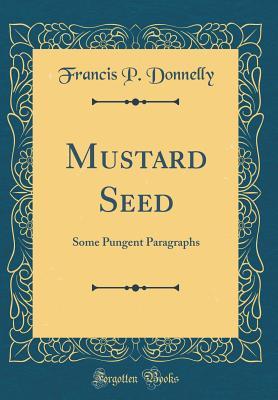Read Mustard Seed: Some Pungent Paragraphs (Classic Reprint) - Francis P. Donnelly file in PDF
Related searches:
Some have wondered why, in the parable of the mustard seed, jesus calls the mustard seed the “smallest” of seeds and the mature mustard plant the “largest” of plants in the garden, when there were smaller seeds and larger plants. The answer is that jesus is using rhetorical hyperbole—an exaggeration to make a point.
The seeds are sometimes ground before liquid is added or the mixture is processed afterward. There are 3 types of mustard seeds: yellow (or white) mustard seeds: these are the most widely available and most popular. Brown mustard seeds: these are more pungent that yellow mustard seeds and are quickly gaining popularity.
Mustard is a condiment made from the seeds of a mustard plant the whole, ground, cracked, the seed itself has a strong, pungent, and somewhat bitter taste. Some of the many vitamins and nutrients found in mustard seeds are seleni.
Mustard seed some pungent paragraphs available to buy online at takealot.
Join the discussion about “a grain of mustard seed” and other short stories. Ask and answer questions about the novel or view study guides, literature essays.
The one exception to yellow mustard seeds are the smaller variety that is popular in south east asia. They are strong and pungent compared to the larger yellow mustard seeds. Some also refer to yellow mustard seeds as white mustard seeds.
Some scholars and botanists believe that the biblical mustard seed and tree was the brassica nigra. Brassica nigra is also known as sinapis nigra, black mustard, and shortpod mustard. Others believe it was the salvadora perscia commonly called the toothbrush tree.
Mustard ranks with plants that please us by irritating us and causing pain. They deliver volatile, pungent chemicals that begin in the food and travels through the air to irritate mouth and nasal passages. Mustard, along with cousins’ horseradish and wasabi, are part of the cabbage family.
April 29, 1981; german mustards usually have ground mustard seed, vinegar, salt and spices, with flour fillers and sugar sometimes.
Mustard seeds of weight 11 grams in one serving contain the following nutrients. It has 52 calories, 3 grams fat, 1mg sodium, 0mg cholesterol, 2 grams of carbohydras and 3 grams of proteins. Apart from this, the dietary value of calcium, iron, vitamin c, vitamin a are 65, 6%, 1% and 0% respectively in this quantity.
Oriental mustard seed (brassica juncea) is very hot and pungent, has a higher a low grade chinese mustard, but also is used as an ingredient by some spice.
Excerpt from mustard seed: some pungent paragraphs and here is another parable! when the writer was at college, he heard during a retreat the following story. Once upon a time a man was carrying upon his shoulder a sharp scythe and was much bothered by a cur barking at his heels.
Mustard is a pungent plant that has many culinary and medicinal uses. Folk medicine calls for a mustard plaster to be applied externally for ailments such as arthritis. Mustard oil is high quality, and useful in medications because it does not go rancid.
29 may 2014 in it's essence, mustard is combination of mixing the ground seeds of mustard enzymes and break down some of the pungent compounds,.
Brown mustard seeds are less spicy than black and spicier than white mustard seeds, as can be seen in most types of brown mustard condiments. White mustard seeds are milder than brown or black mustard seeds, but they still contain pungent flavor producers, especially sinalbin.
They are the largest of the seeds and have the mildest flavor. (2) brown mustard seeds, which are popular in europe and asia, sometimes go by the name ‘chinese mustard’ and are medium size and pungent. (3) black mustard seeds, which was from india, are the smallest and the most potent and spicy of the three.
One produces pungent brown seeds, which have a sharp, spicy-hot flavor and are used in dijon mustards; the other yields milder, yellowish-white seeds used to make traditional american mustard. Purchase� since the mustard plant is grown all over the world, seeds of both colors are widely available.
The whole mustard seed has no flavour, but can provide a pungent taste after chewing (hirasa and takemasa, 1998). The heat experienced in yellow mustard is on the tongue, whereas in brown and black mustard the heat is also felt in the nose and eyes. The severity of pungent aroma varies with different mustards.
A closer look at the mustard seed with its pungent taste and fiery effect, mustard is extremely beneficial for the health. It grows entirely wild, though it is improved by being transplanted.
Mustard oil is an essential oil resulting from grinding the seeds, mixing them with water, and the characteristic pungent flavour of mustard oil is due to allyl isothiocyanate.
Practically speaking there are three main types of mustard plants, black, brassica negra, brown, brassica juncea, and white, sinapis alba. Black and brown mustard have a higher content of glucosinolates and are more pungent than yellow mustard seeds.

Post Your Comments: